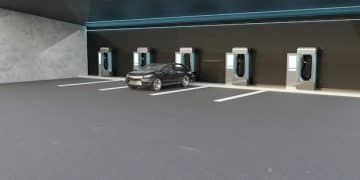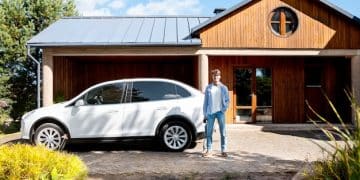Car Buying Guide 2025: Navigating New Fuel Efficiency Standards
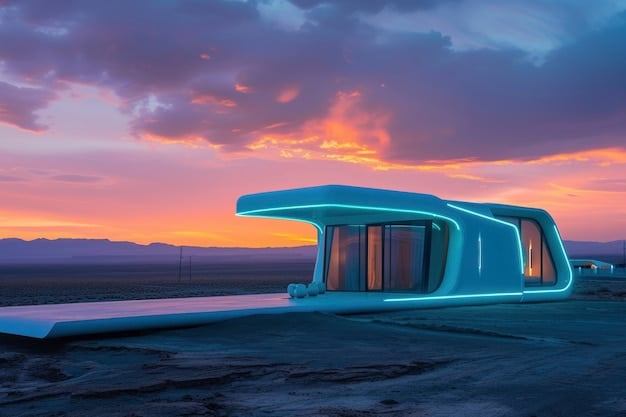
Car Buying Guide 2025: Understanding the Impact of New Federal Fuel Efficiency Standards helps consumers navigate the evolving landscape of fuel efficiency standards, ensuring they make informed decisions about their vehicle purchases in light of these new regulations.
Navigating the automotive market requires staying updated with the latest regulations. The Car Buying Guide 2025: Understanding the Impact of New Federal Fuel Efficiency Standards is crucial for making informed decisions about your next vehicle purchase.
The Shifting Landscape of Fuel Efficiency Standards
The automotive industry is constantly evolving, driven by technological advancements and regulatory changes. Understanding the new fuel efficiency standards is key to making informed decisions when buying a new car. These standards not only impact the environment but also influence the cost and performance of vehicles.
New federal fuel efficiency standards are set to reshape the automotive market. These standards aim to reduce greenhouse gas emissions and promote the adoption of more fuel-efficient vehicles. As a result, car manufacturers are investing in innovative technologies to meet these requirements.
Understanding CAFE Standards
The Corporate Average Fuel Economy (CAFE) standards are at the forefront of these changes. These standards mandate the average fuel economy that a manufacturer’s fleet of vehicles must achieve. Here’s what you need to know:
- Increased Stringency: CAFE standards are becoming more stringent, requiring automakers to produce vehicles with higher fuel efficiency ratings.
- Compliance Mechanisms: Automakers can comply through various means, including improving engine technology, reducing vehicle weight, and increasing the production of electric vehicles.
- Impact on Consumers: These standards directly affect the types of vehicles available, their performance, and their long-term cost of ownership.
The Role of the EPA
The Environmental Protection Agency (EPA) plays a crucial role in setting and enforcing fuel efficiency standards. Here’s how the EPA contributes to these efforts:
- Setting Emission Standards: The EPA sets standards for vehicle emissions, including greenhouse gases, which indirectly affects fuel efficiency.
- Testing and Certification: The EPA conducts testing and certification of vehicles to ensure compliance with these standards.
- Incentive Programs: The EPA also offers incentive programs to encourage the development and adoption of fuel-efficient technologies.
In conclusion, the landscape of fuel efficiency standards is dynamic and complex. Staying informed about CAFE standards and the role of the EPA is essential for making smart car-buying decisions.
How New Standards Impact Vehicle Technology
The push for higher fuel efficiency is driving significant innovation in automotive technology. Automakers are developing and integrating a range of advanced technologies to meet the new standards. These technologies not only improve fuel economy but also enhance vehicle performance and reduce emissions.
These new federal fuel efficiency standards are not just about compliance; they are about innovation. Automakers are investing heavily in research and development to create vehicles that are both environmentally friendly and appealing to consumers.
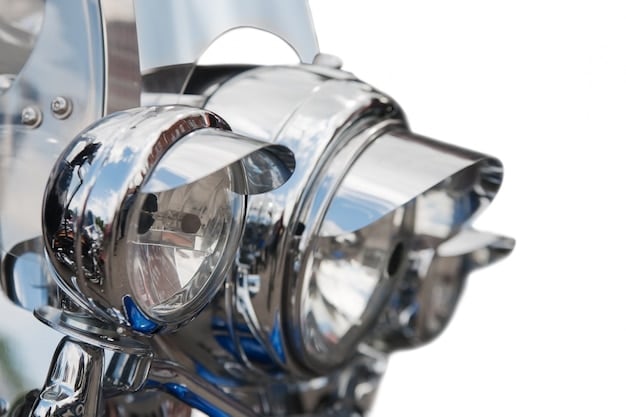
Electric Vehicles (EVs)
Electric vehicles are at the forefront of the fuel efficiency revolution. EVs offer zero tailpipe emissions and can significantly reduce a vehicle’s carbon footprint. Here’s why EVs are gaining traction:
- Zero Emissions: EVs produce no tailpipe emissions, making them a cleaner alternative to gasoline-powered vehicles.
- Government Incentives: Many governments offer tax credits and rebates to encourage the purchase of EVs.
- Improved Range: Advancements in battery technology are increasing the range of EVs, making them more practical for everyday use.
Hybrid Technology
Hybrid vehicles combine a gasoline engine with an electric motor to improve fuel efficiency. There are several types of hybrid systems, each offering different levels of efficiency and performance:
- Mild Hybrids: These vehicles use an electric motor to assist the gasoline engine, improving fuel economy without providing full electric driving capabilities.
- Full Hybrids: Full hybrids can operate on electric power alone for short distances, enhancing fuel efficiency in urban environments.
- Plug-in Hybrids (PHEVs): PHEVs can be plugged in to recharge their batteries, offering a combination of electric and gasoline power for extended range and efficiency.
In summary, new federal fuel efficiency standards are driving innovation in vehicle technology. Electric and hybrid vehicles are becoming increasingly prevalent, offering consumers more options for reducing their environmental impact.
Consumer Choices: Balancing Efficiency and Performance
When buying a new car, consumers often face the challenge of balancing fuel efficiency with performance. The new fuel efficiency standards are influencing this balance, as automakers strive to meet regulatory requirements while still delivering vehicles that satisfy consumer demands. Understanding these trade-offs is essential for making the right choice.
The Car Buying Guide 2025: Understanding the Impact of New Federal Fuel Efficiency Standards is about making the right decision for your unique needs. The guide will assist you in learning to weigh your needs against your responsibilities to the environment.
Understanding Fuel Economy Ratings
Fuel economy ratings, such as miles per gallon (MPG), are a key factor in assessing a vehicle’s efficiency. Here’s how to interpret these ratings:
- City vs. Highway: Fuel economy ratings typically differ between city and highway driving, reflecting the varying conditions and speeds.
- Real-World Performance: Real-world fuel economy may vary from the advertised MPG due to factors such as driving habits, weather conditions, and vehicle maintenance.
- Total Cost of Ownership: Consider the long-term cost of ownership, including fuel costs, maintenance, and potential tax incentives.
Factors Affecting Performance
Several factors can affect a vehicle’s performance, including engine type, vehicle weight, and aerodynamic design. Here’s how these factors relate to fuel efficiency:
- Engine Size: Smaller engines generally offer better fuel economy but may sacrifice some level of performance.
- Vehicle Weight: Lighter vehicles tend to be more fuel-efficient, but weight reduction must be balanced with safety considerations.
- Aerodynamics: Aerodynamic design can reduce drag and improve fuel efficiency, especially at higher speeds.
In conclusion, balancing fuel efficiency and performance requires careful consideration of your driving needs and preferences. Understanding fuel economy ratings and the factors affecting performance can help you make an informed decision.
The Financial Implications of Fuel Efficiency Standards
The new federal fuel efficiency standards have significant financial implications for both automakers and consumers. These standards affect the cost of producing vehicles, the prices consumers pay, and the long-term cost of ownership. Understanding these financial considerations is crucial for making economically sound car-buying decisions.
The financial aspects of Car Buying Guide 2025: Understanding the Impact of New Federal Fuel Efficiency Standards are crucial. The guide will help you to ensure you are making sound decisions when it comes to buying a new car.
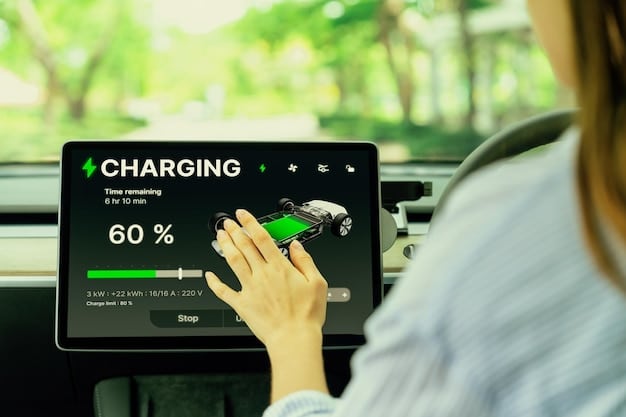
Initial Purchase Price
Fuel-efficient vehicles, particularly EVs and hybrids, often have a higher initial purchase price compared to traditional gasoline-powered cars. This premium reflects the advanced technology and materials used in these vehicles.
- Technology Costs: The cost of batteries, electric motors, and other advanced components can contribute to a higher purchase price.
- Government Incentives: Tax credits and rebates can help offset the higher initial cost of fuel-efficient vehicles.
- Long-Term Savings: While the initial cost may be higher, fuel-efficient vehicles can offer significant long-term savings through reduced fuel costs.
Fuel Costs and Savings
One of the primary financial benefits of fuel-efficient vehicles is reduced fuel costs. EVs, in particular, can offer substantial savings by eliminating the need for gasoline altogether.
- MPG Improvements: Even small improvements in MPG can result in significant savings over the life of the vehicle.
- Electricity vs. Gasoline: The cost of electricity is generally lower than the cost of gasoline, making EVs a more economical choice for many drivers.
- Maintenance Costs: EVs typically have lower maintenance costs due to fewer moving parts and the absence of oil changes and other routine maintenance tasks.
In summary, the financial implications of new fuel efficiency standards are complex and multifaceted. While fuel-efficient vehicles may have a higher initial cost, they can offer substantial long-term savings through reduced fuel and maintenance costs.
Future Trends in Automotive Fuel Efficiency
The automotive industry is constantly evolving, and future trends in fuel efficiency are poised to transform the way vehicles are designed, powered, and used. Emerging technologies and changing consumer preferences are driving these trends, promising even greater efficiency and sustainability in the years to come. Staying informed about these trends can help you anticipate future changes in the automotive market.
The outlook is that Car Buying Guide 2025: Understanding the Impact of New Federal Fuel Efficiency Standards is not only a guide for now but a guide that will continue to evolve with our society. It is ever changing.
Advancements in Battery Technology
Continued advancements in battery technology are crucial for the future of EVs. These advancements will lead to increased range, faster charging times, and lower battery costs.
- Solid-State Batteries: Solid-state batteries offer higher energy density and improved safety compared to traditional lithium-ion batteries.
- Fast Charging: Developments in fast-charging technology will reduce the time it takes to recharge an EV, making them more convenient for long-distance travel.
- Reduced Costs: Economies of scale and technological innovation will drive down the cost of batteries, making EVs more affordable for a wider range of consumers.
Hydrogen Fuel Cell Technology
Hydrogen fuel cell technology is another promising avenue for achieving zero-emission transportation. Fuel cell vehicles combine hydrogen with oxygen to produce electricity, with water as the only byproduct.
- Zero Emissions: Fuel cell vehicles produce no tailpipe emissions, making them a clean alternative to gasoline-powered cars.
- Long Range: Fuel cell vehicles can offer similar range to gasoline-powered cars, with refueling times comparable to filling a gas tank.
- Infrastructure Challenges: The widespread adoption of fuel cell vehicles depends on the development of a hydrogen refueling infrastructure.
In conclusion, future trends in automotive fuel efficiency are promising and diverse. Advancements in battery technology and the development of hydrogen fuel cell technology are paving the way for a future of cleaner, more sustainable transportation.
Making Informed Decisions in 2025
As you navigate the car-buying process in 2025, it’s essential to make informed decisions based on your individual needs, preferences, and financial situation. The new federal fuel efficiency standards are reshaping the automotive market, offering consumers a wider range of choices for achieving greater efficiency and sustainability.
Car Buying Guide 2025: Understanding the Impact of New Federal Fuel Efficiency Standards is to ensure everyone has the opportunity to participate in the car buying experience.
Assessing Your Needs
Begin by assessing your driving needs and priorities. Consider factors such as your daily commute, long-distance travel requirements, and cargo capacity needs.
- Driving Habits: Evaluate your driving habits, including the amount of city vs. highway driving you typically do.
- Vehicle Size: Determine the appropriate vehicle size based on your passenger and cargo needs.
- Budget: Set a realistic budget for your new car, taking into account the initial purchase price, fuel costs, and maintenance expenses.
Researching Available Options
Research the available options, paying close attention to fuel economy ratings, performance characteristics, and available incentives. Consult with trusted sources such as consumer reports, automotive publications, and online reviews.
- Test Drives: Take test drives of several different vehicles to get a feel for their driving dynamics and comfort.
- Compare Models: Compare different models side-by-side, focusing on the features and specifications that are most important to you.
- Consult Experts: Seek advice from automotive experts and financial advisors to make a well-informed decision.
In summary, making informed decisions in 2025 requires careful assessment of your needs, thorough research of available options, and consultation with trusted sources. By taking these steps, you can choose a vehicle that meets your requirements while also contributing to a more sustainable future.
| Key Point | Brief Description |
|---|---|
| 🌱 New Standards | Fuel efficiency standards are becoming more stringent in 2025. |
| ⚡️ EVs & Hybrids | Electric and hybrid vehicles are key to meeting the new standards. |
| 💰 Financial Impact | Consider long-term savings in fuel and maintenance costs. |
| 💡 Future Tech | Advancements in batteries and hydrogen fuel cells are coming. |
FAQ
▼
The new standards are regulations set by the government to increase the average fuel economy of vehicles sold in the US, aiming to reduce greenhouse gas emissions and promote energy conservation.
▼
The standards encourage automakers to produce and sell more EVs to meet the overall fuel economy targets, leading to greater EV availability and potentially lower prices due to increased production.
▼
Fuel-efficient cars typically have lower fuel costs, and some may qualify for tax incentives or rebates. They may also have lower maintenance costs compared to traditional gasoline vehicles.
▼
Emerging technologies like solid-state batteries, advanced hybrid systems, and hydrogen fuel cells promise to further improve fuel efficiency and reduce emissions in future vehicles.
▼
Consider your driving habits, budget, and environmental concerns. Research available options, compare fuel economy ratings, and take test drives to find a vehicle that suits your needs and preferences.
Conclusion
Staying informed about the Car Buying Guide 2025: Understanding the Impact of New Federal Fuel Efficiency Standards, is essential to making the right consumer choices. Doing your due diligence and being dedicated to making the right choices is crucial.


